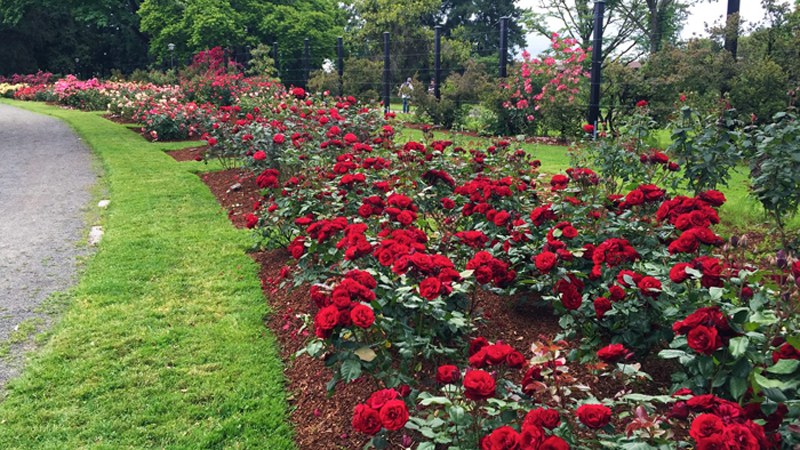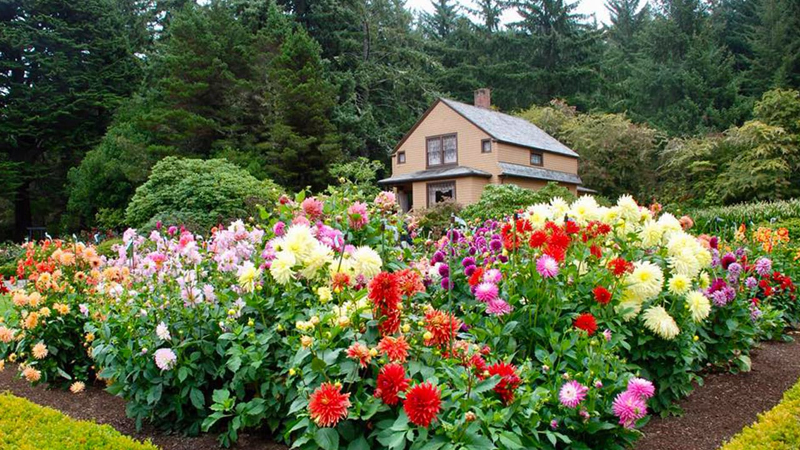Republished with permission from TravelOregon.com
Gardens not only make the world a more beautiful place, they’re good for you. In fact, plants make life healthier. Researchers have found that people who spend time outdoors basking in the beauty of plants — in gardens, parks and other green spaces — benefit from increased activity, leading to improved physical health, reduced stress and lower health care costs. Thanks to our mild oceanic climate, warm summers and wet winters, Oregon is one of the most botanically lush states in the nation, ranking fifth nationally for plant species diversity. That makes Oregon a great place to get a heaping dose of natural goodness.
The Portland region alone has more than 150 public gardens, plant nurseries and gardening stores. Beyond the metropolitan area, the Willamette Valley is home to an enormous plant nursery and greenhouse industry in addition to being the epicenter for wine. Elsewhere around the state, naturalists will appreciate the state’s healthy assortment of native plants that thrive in just about every climate — from scrappy beach scrub on the coast to the shrub-steppe grasslands in the high desert.
Here’s a lineup of some of the loveliest gardens and lushest landscapes Oregon has to offer.

Portland Region: Plant-landia
Tops among the Rose City’s must-see gardens is Lan Su Chinese Garden in Old Town/Chinatown, celebrating its 20th anniversary in 2020, and the Portland Japanese Garden, which expanded significantly in 2017. Japanese architect Kengo Kuma — best known for designing Tokyo’s new Olympic Games stadium — transformed part of the land and new facilities designed for visitors interested in Japanese gardening and culture. Nearby, the International Rose Test Garden attracts visitors with its endless variety of showy and fragrant blooms in early summer.
About a 25-minute drive south of Stumptown, the Rogerson Clematis Garden in West Linn showcases North America’s most comprehensive collection of clematis. This plant species spans many diverse flowering vines and woody shrubs of all shapes, colors and sizes, and it grows on every continent (except Antarctica) — from the frozen tundra of Siberia to the jungles of Papua New Guinea. In all, the garden showcases nearly 100 varieties of clematis growing among over 1,900 plants in 14 unique planting areas, with large wayfinding signage that was funded with support from a Travel Oregon local tourism grant.

(Photo by Sally McAleer / Eugene, Cascades & Coast)
Willamette Valley: Stimulate the Senses
It’s not just wine that will put a rosy glow on your face in the valley. From spring to fall, the Owen Rose Garden in Eugene is a prime place to commune with nature, relax and feel good. Set along the Willamette River, the garden sprawls over 8 acres and has more than 4,500 rose bushes and climbing roses in 400 varieties, planted along accessible gravel paths with benches and a pergola-lined, paved walkway. Another prominent garden feature is the Oregon Heritage Cherry Tree. Planted in 1847, it’s believed to be the country’s oldest and largest Black Tartarian, an heirloom variety of cherry tree prized for its large, sweet, rich fruit.
Also in the Willamette Valley, spectacular specialty-themed gardens shine at the Oregon Garden, an extraordinary 80-acre botanical garden in Silverton, about 12 miles northeast of Salem. The Sensory Garden, for example, is a therapeutic space full of aromatic and textural plants set in a visually stunning garden with a 20-foot-long rain curtain. The Medicinal Garden showcases rosemary, wall germander, lavender, oregano and coneflower among a collection of plants used to treat ailments of the body. The Oregon Garden offers much more to inspire the imagination: 20-plus themed areas, each displaying the diverse botanical beauty that is capable of growing in the Willamette Valley and throughout the Pacific Northwest.

Oregon Coast: Find Bliss on the Bluff
Ocean air has long been revered for its health benefits. The negative ions in the salty spray accelerate the body’s ability to absorb oxygen and balance levels of serotonin, a chemical linked with mood and stress. What’s good for landlubbers is doubly good for plants.
Perched on a rugged sandstone cliff high above the Pacific Ocean, Shore Acres State Park was built in 1905 as a private estate with luxurious gardens planted with trees, shrubs and flowers brought from around the world aboard the sailing ships of pioneer lumberman and shipbuilder Louis J. Simpson. Today the park features 5 acres of plantings, including a formal English rose garden and a Japanese-style garden built around a 100-foot lily pond that Claude Monet would have envied. Taking full advantage of Oregon’s mild coastal climate, Shore Acres is resplendent in every season. Hardy bulbs — daffodils and tulips — by the thousands start blooming in late winter to early spring, followed by hundreds of rhododendrons and azaleas, and dahlias that dazzle from summer well into the fall.
Also on the Coast, Darlingtonia State Natural Site in Florence dedicates its 18 acres of accessible gardens to showcasing and protecting a single species: the rare cobra lily, a carnivorous plant that is the only member of the pitcher plant family (Sarraceniaceae) in Oregon.

Columbia River Gorge: Gorgeous Geology
With its scorching summers, frosty winters and tempestuous winds, the Columbia Gorge might seem too challenging for life to take root. However, for Native Americans, who have lived here for well over 10,000 years, this landscape has been a great storehouse of life-sustaining flora and fauna.
The Columbia Gorge Discovery Center in The Dalles celebrates the region’s rich cultural and natural history. Once the site of a concrete-mix plant, the center’s grounds are now home to an interpretive center and a 50-acre panorama, including a pond, wetlands, and scenic vistas of the Columbia River and Klickitat Hills. An accessible paved interpretive trail is perfect for bicycling, jogging or strolling while learning about the native plant restoration project. From early spring to late fall, the grounds are graced with over 100 species of blooming indigenous plant species resistant to the harsh, windblown environment. Cottonwoods, willows, cattails and sedges give shelter and food to turtles, ducks, geese, eagles, raccoons and songbirds.

Southern Oregon: Pristine Preserve
In the fertile Rogue Valley, Pacifica: A Garden in the Siskiyous covers nearly 500 acres in the remote town of Williams, 15 miles south of Grants Pass. The nature center features native vegetation on acreage that hasn’t been farmed or grazed for many years — and the plan is to keep it that way. Hikers can explore over 7 miles of mostly easygoing interpretive trails and experience a variety of undisturbed habitats — from riparian to chaparral, oak savanna to cool montane — each supporting different types of native birds and plants. They have public access for horse riding, catch and release fishing, and bird watching. They are also a venue for weddings and other private events.
In contrast, the botanic garden showcases landscaped gardens, such as the Rock Garden by renowned rock garden designer Josef Halda, who constructed a 60-foot rock waterfall to showcase native alpine plants. The Western Native Plant Garden was constructed with the home gardener in mind, showing ways native plants can be used to create screens, borders and all-season color in home landscapes.
Eastern Oregon: High-Desert Oasis
The mild, maritime climate of Western Oregon contrasts greatly with Eastern Oregon’s much drier high-desert landscape. Plants that survive here must be hardy enough to withstand great seasonal variations in temperature or have the help of a farmer’s nurturing hand.
The River to Hills Farm Loop is a 60-mile route that extends from Boardman to Pendleton and many points in between. Over 20 farm stands along the way offer blueberries, lavender and the incomparably sweet Hermiston watermelons and cantaloupes. The loop features one formal garden: Bennett Botanical Garden in Hermiston. This verdant outdoor event space and 5-acre garden features lush green grass, mature shade trees, blooming shrubs and annual color. Created by Doug Bennett, a landscape designer, and Kris Bennett, owner of a local floral-design studio, the garden is open to the public by appointment only.

Central Oregon: Fun in the Sun
Sunbirds flock to the resort and residential community of Sunriver for its 300 days of annual sunshine and a variety of activities including hiking, biking, golfing and paddling the Deschutes River.
Located next to Lake Aspen and nestled among 8 acres of pine forest, wetland and meadow habitats, Sunriver Nature Center & Observatory has a botanical garden loaded with pollinator-friendly wildflowers: larkspur, lupine, yarrow, fireweed, desert paintbrush and sagebrush. Naturalists lead botanical hikes around the grounds, pointing out the grasses, shrubs, fungi, mosses and lichen native to the region’s unique semi-arid climate.
From sandy beaches to dense forests, high desert to lush valleys, Oregon has the floral diversity to please master gardeners and budding naturalists alike.

